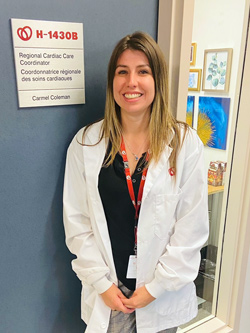
Data scientists at the University of Ottawa Heart Institute (UOHI) have developed and tested a clinical model to accurately predict the risk of death and unplanned cardiac hospitalization for patients awaiting heart surgery.
Unplanned cardiac hospitalization refers to nonelective (urgent) admission to hospital for heart failure, myocardial infarction (heart attack), unstable angina (unexpected chest pain) or endocarditis (an infection of the heart's inner lining or heart valves) while on the waitlist.
This model is intended to facilitate patient-centered decision-making, improve patient outcomes, and along with other models developed by the group, to maximize the allocation of essential health care resources.
An extra tool in the box for practitioners and administrators
“Given the medical complexity of cardiac patients and the risk of them getting sicker while awaiting surgery, this data-driven approach promotes individualized wait times and affirms safe and timely triaging decisions,” explains Dr. Louise Sun who spearheaded the project, a cardiac anesthesiologist and data scientist at the UOHI, and an adjunct scientist with the Institute for Clinical Evaluative Sciences (ICES).
“Our model is an extra tool in the box to support referring physicians and the operating team, as well as health care administrators, through time-dependent, individualized risk prediction.”
- Dr. Louise Sun
A robust population study with profound implications for patient care

Using datasets from the clinical registry of CorHealth Ontario and population-level administrative health care databases from ICES, Dr. Sun and her team conducted a population-based, retrospective cohort study to develop and test the calculator. Results are highlighted in the Canadian Medical Association Journal (CMAJ).
More than 60,000 residents across Ontario were included in the study, all of whom were over the age of 18 and on the waitlist for either aortic, mitral, or tricuspid valve surgery, coronary artery bypass grafting (CABG), or surgery on the thoracic aorta between October 2008 and September 2019.
Researchers randomly split the study cohort into two groups: Two-thirds to inform the model, and the remaining third to validate it.
In analyzing the data, study authors identified features of patients they say are “at the highest risk” for death or unplanned cardiac hospitalization while on the surgery waitlist.
“Our analysis revealed patients who were male, lived in urban areas, had more severe cardiac symptoms, were treated at teaching hospitals, and were awaiting surgery for specific procedures such as CABG were at elevated risk for death or unplanned hospitalization,” said Dr. Sun.
Understanding who is at greatest risk helps care teams determine those most likely to benefit from expedited surgery.
Decision aid benefits administrators, too.

Carmel Coleman, a surgical triage coordinator and registered nurse at the UOHI, has been using variations of the Cardiac Surgery Waitlist Score since March of 2020.
“This tool has become such a fundamental component of my every day,” she said. “Every time a patient is referred for cardiac surgery, our team runs them through the application before entering them into the system and prioritizing their booking."
Using the tool, Coleman and her staff can also differentiate between flythrough cases and those who may require longer hospital stays, and they can schedule all cases in such a way to preserve flow and capacity in the cardiac surgery intensive care unit, meaning more patients can be admitted for surgery without sapping vital resources or holding up those in the queue.
Among the things Coleman appreciates most about the tool is how it provides an effective and quantifiable means to support which candidates are selected and scheduled into the operating room.
“You cannot argue with numbers,” she said. “When administrators can provide full justification and rational for each patient they schedule for surgery, and can back up their selection with hard data, they are relieved of the stress associated with making such important care decisions.”
Scheduled cases are routinely discussed and agreed on in meetings with the heads of cardiac surgery and anesthesiology.
Are machines and algorithms taking over?
The Cardiac Surgery Waitlist Score calculator, Dr. Sun said, is meant to augment and not to replace human intelligence or intuition.
“Clinical judgement is built on years of training and practical experience in medicine. It’s an artform that simply cannot and will not be replaced entirely by machines,” she said. “However, by using data-driven support tools, we can allocate resources judiciously and make informed decisions concerning who is chosen for surgery and when.”
Coleman agrees. “Support aids like these guarantee the care team, the patient and their family, that decisions about the next day's cases are fully justified because they are backed by real-world evidence."
To date, Dr. Sun and her team at the UOHI and ICES have developed point-of-care apps and integrated software platforms for waitlist management, capacity planning and scheduling to share with hospitals and healthcare jurisdictions during the COVID-19 crisis and beyond.
“Our clinical services team has been using a calculator to predict the length of stay in our intensive care unit, and a waitlist tool to triage every patient who comes through the surgery referral pipeline,” said Dr. Sun.
“While other centres reduced their annual procedure volumes, we managed to perform close to our usual cardiac surgery volumes while still keeping enough ICU beds open for COVID.”

